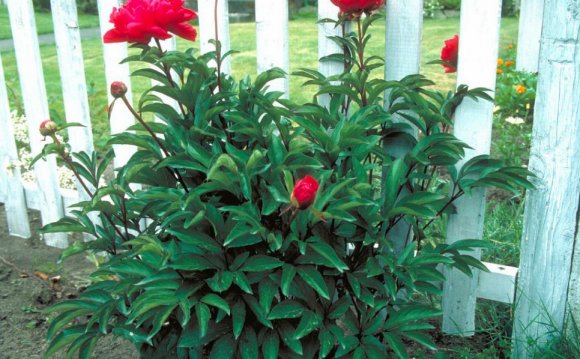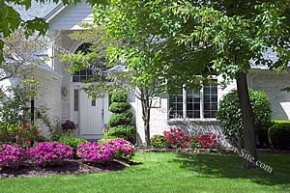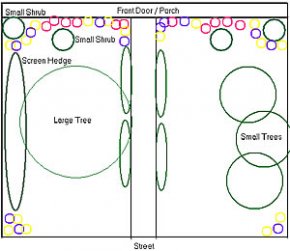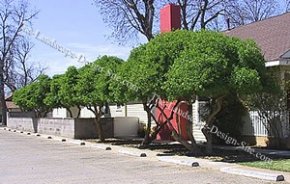
 Ask me what’s behind the simplest and most functional landscaping planting ideas I’ve seen or created and I’ll have to say it is simplicity and repetition. Second to that is texture and the creative use of green foliage plants.
Ask me what’s behind the simplest and most functional landscaping planting ideas I’ve seen or created and I’ll have to say it is simplicity and repetition. Second to that is texture and the creative use of green foliage plants.
Now, if I was only allowed to give you one piece of advice on how to create your own planting idea or plan, it would be repetition (see examples of repetition). Pick a few plants, trees, and flowers, repeat them throughout your landscaping, and you have a framework and starting point. Or even possibly a finished plan.
In most (not all) of the designs I create, there will be at least one plant type, species, or color that I repeat throughout the entire design. While this may not always be my starting point, for you it may be a way to take the first step. And possibly to immediately add an element and direction to the plan.
In many cases it’s entirely possible to get your landscaping planting ideas simply by looking through pictures of landscaping or copying someone elses ideas. I’m all for the easiest way as long as the results are lasting. However, simply basing your plant choices on color, size, and whether a plant serves as a tree, bush, or flower, leaves a lot of room for error. If you’re not at least paying attention to whether or not a plant is even zoned for your area, you could be throwing money right out the window.
For creative and functional planting ideas in new and existing landscaping, you should first recognize all the functions and purposes plants can perform. Beyond simply adding color or curb appeal, plants can be used to create canopies, hedges, screening, wind breaks, erosion control, borders, fences, noise reduction, ground cover, and a number of other aspects.
 Lay out a simple bubble graph like the one to the right to determine necessary areas and then define plant types (flower, tree, hedge, etc.) needed. To research for specifics and matches you can use the plant database list.
Lay out a simple bubble graph like the one to the right to determine necessary areas and then define plant types (flower, tree, hedge, etc.) needed. To research for specifics and matches you can use the plant database list.
It may actually be easier for you to create a planting scheme if you first consider the plants in your design in regards to their function or purpose. Of course, all the plants in your landscaping will have a purpose even if it’s just to look pretty and take up space. However, for this definition we’ll say that functional is any plant that has a purpose such as a canopy, hedge, screening, wind break, border, groundcover, etc.
By considering plant functions first, you might be able to narrow the rest of your planting scheme down to a few cover, color, or fill areas. Of course, in the name of “simplicity” and “being done with it”, you could even cut the rest of your project down further by using professionally designed pre-planned garden designs.
Creating a thriving, functional, and long lasting planting scheme won’t be without any effort. Even though you can get planting layout and color ideas from pictures, gardens, and books, choosing the right plants, shrubs, flowers, and trees will require a little knowledge.
 Primary Considerations For Choosing The Right Garden And Landscaping Plants
Primary Considerations For Choosing The Right Garden And Landscaping Plants
- Plant Width and Height
should be figured by the mature size a plant will get to be in both up and spread outward directions. Overplanting and unerplanting are common mistakes. Most landscaping is planted in with immature plants so it’s easy to unintentionally overplant.
Overplanting smaller plants and bed areas doesn’t cause much problem and may sometimes be desirable as they can be thinned later. However, trees and larger plants and shrubs may also create a threat to surrounding elements and structures.
Trees, shrubs, and larger plants also need consideration for root space.
Again, you gotta know your stuff to keep from making some costly mistakes..
- Form
is the shape of a plant and how it occupies and accents an area. Common form and shapes are oval, round, creeping, columnar, vase, weeping.
Considering form is useful to see how plants can work with each other and other elements. For instance, columnar plants can be used to frame an area, view, or focal point. Creeping plants can create a colorful ground cover alternative to plain bark mulch.
- Texture
can be considered in terms of leaf thickness, fineness or roughness, and shade(light or dark) of plants. Adding texture as a consideration may take a little more thought. However, it is a great opportunity to create contrasts and transitions.















